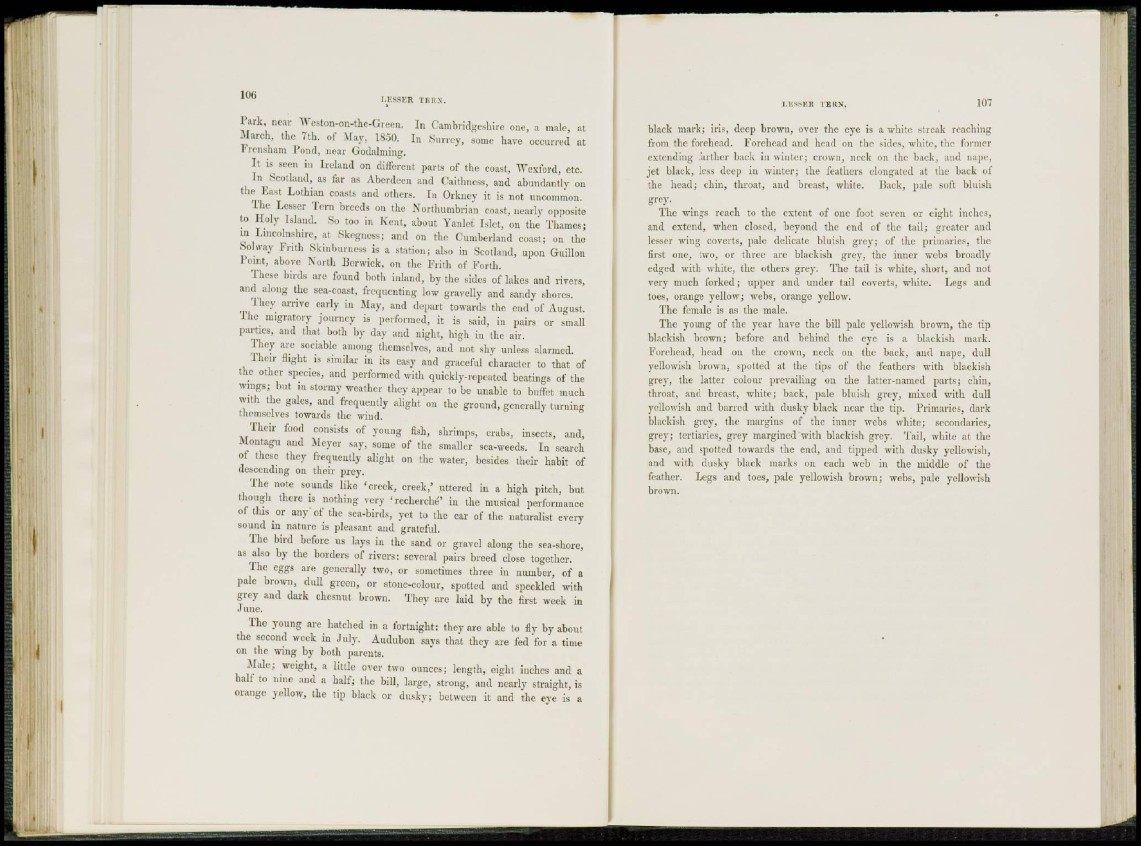
Park, near Weston-on-the-Green. In Cambridgeshire one, a male, at
.March, the 7th. of May, 1850. In Surrey, some have occurred at
Frensham Pond, near Godalniing.
I t is seen in Ireland on different parts of the coast, Wexford, etc.
In Scotland, as far as Aberdeen and Caithness, and abundantly on
the East Lothian coasts and others. In Orkney it is not uncommon.
The Lesser Tern breeds on the Northumbrian coast, nearly opposite
to Holy Island. So too in Kent, about Yanlet Islet, on the Thames;
in Lincolnshire, at Skegness; and on the Cumberland coast; on the
Sol way Frith Skinburness is a station; also in Scotland, upon Guillon
Point, above North Berwick, on the Frith of Forth.
These birds are found both inland, by the sides of lakes and rivers,
and along the sea-coast, frequenting low gravelly and sandy shores.
They arrive early in May, and depart towards the end of August.
The migratory journey is performed, it is said, in pairs or small
parties, and that both by day and night, high in the air.
They are sociable among themselves, and not shy unless alarmed.
Their flight is similar in its easy and graceful character to that of
the other species, and performed with quickly-repeated beatings of the
wings; but in stormy weather they appear to be unable to buffet much
with the gales, and frequently alight on the ground, generally turning
themselves towards the wind.
Their food consists of young fish, shrimps, crabs, insects, and,
Montagu and Meyer say, some of the smaller sea-weeds. In search
of these they frequently alight on the water, besides their habit of
descending on their prey.
The note sounds like 'creek, creek,' uttered in a high pitch, but
though there is nothing very 'recherche' in the musical performance
of this or any- of the sea-birds, yet to the ear of the naturalist every
sound in nature is pleasant and grateful.
The bird before us lays in the sand or gravel along the sea-shore,
as also by the borders of rivers: several pairs breed close together.
The eggs are generally two, or sometimes three in number, of a
pale brown, dull green, or stone-colour, spotted and speckled with
grey and dark chesnut brown. They are laid by the first week in
June.
The young are hatched in a fortnight: they are able to fly by about
the second week in July. Audubon says that they are fed for a time
on the wing by both parents.
Male; weight, a little over two ounces; length, eight inches and a
half to nine and a half; the bill, large, strong, and nearly straight, is
orange yellow, the tip black or dusky; between it and the eye is a
black mark; iris, deep brown, over the eye is a white streak reaching
from the forehead. Forehead and head on the sides, white, the former
extending farther back in winter; crown, neck on the back, and nape,
jet black, less deep in winter; the feathers elongated at the back of
the head; chin, throat, and breast, white. Back, pale soft bluish
grey.
The wings reach to the extent of one foot seven or eight inches,
and extend, when closed, beyond the end of the tail; greater and
lesser wing coverts, pale delicate bluish grey; of the primaries, the
first one, two, or three arc blackish grey, the inner webs broadly
edged with white, the others grey. The tail is white, short, and not
very much forked; upper and under tail coverts, white. Legs and
toes, orange yellow; webs, orange yellow.
The female is as the male.
The young of the year have the bill pale yellowish brown, the tip
blackish brown; before and behind the eye is a blackish mark.
Forehead, head on the crown, neck on the back, and nape, dull
yellowish brown, spotted at the tips of the feathers with blackish
grey, the latter colour prevailing on the latter-named parts; chin,
throat, and breast, white; back, pale bluish grey, mixed with dull
yellowish and barred with dusky black near the tip. Primaries, dark
blackish grey, the margins of the inner webs white; secondaries,
grey; tertiaries, grey margined with blackish grey. Tail, white at the
base, and spotted towards the end, and tipped with dusky yellowish,
and with dusky black marks on each web in the middle of the
feather. Legs and toes, pale yellowish brown; webs, pale yellowish
brown.